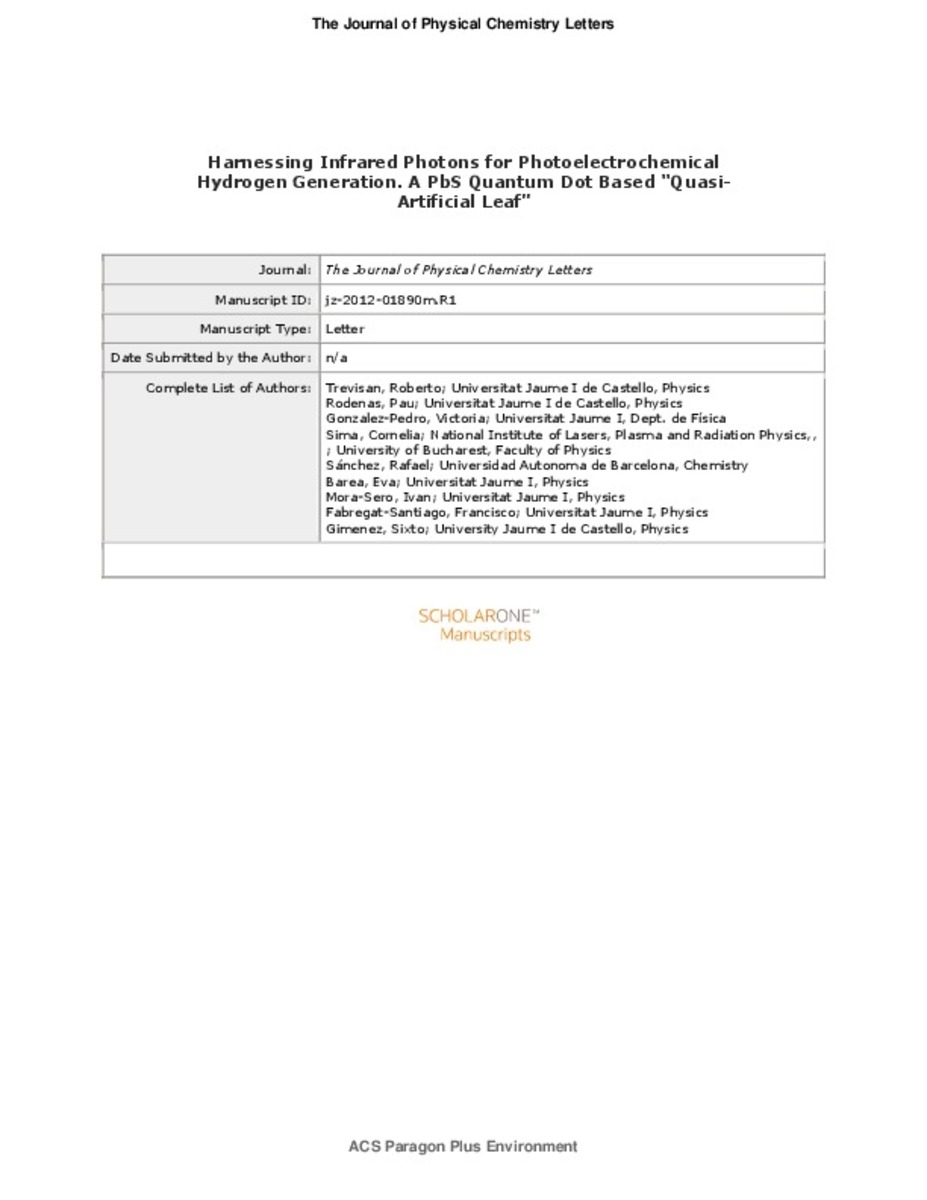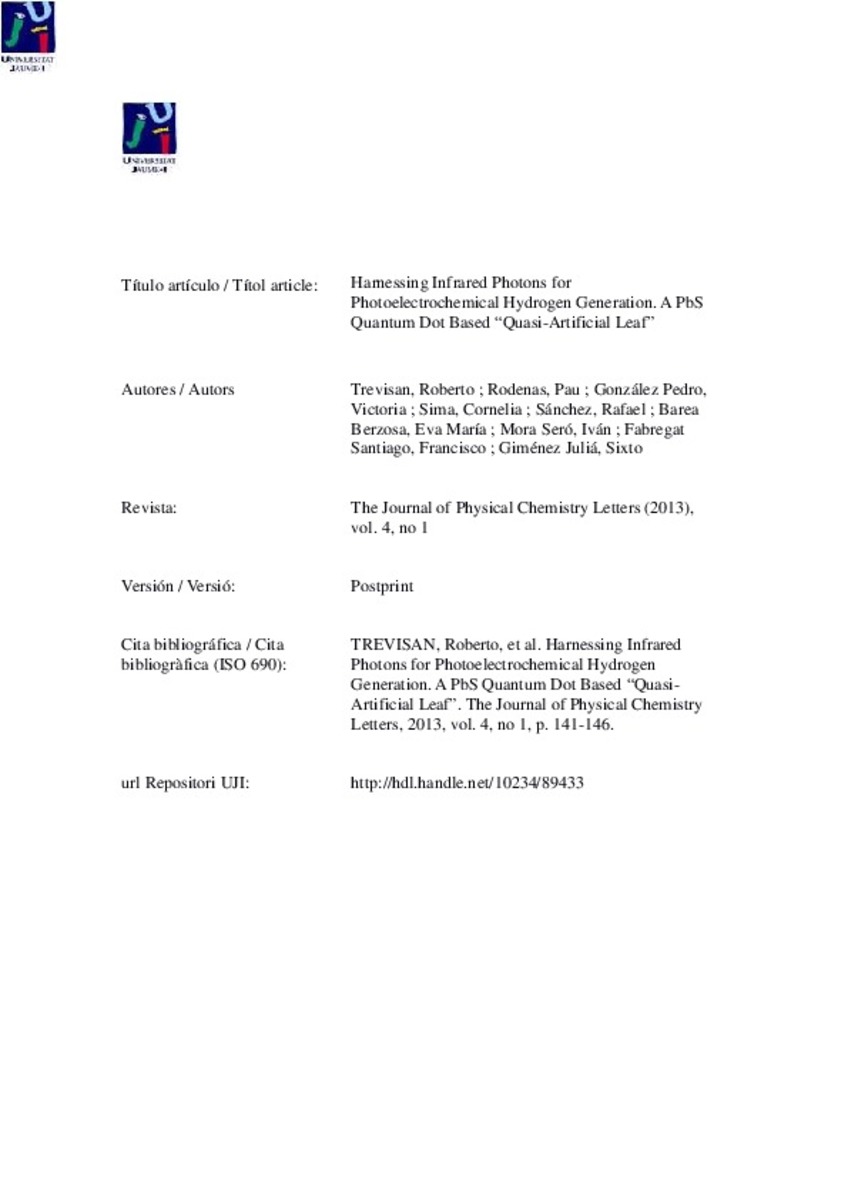Mostrar el registro sencillo del ítem
Harnessing infrared photons for photoelectrochemical hydrogen generation. A PbS quantum dot based "quasi-artificial leaf"
| dc.contributor.author | Trevisan, Roberto | |
| dc.contributor.author | Rodenas, Pau | |
| dc.contributor.author | González Pedro, Victoria | |
| dc.contributor.author | Sima, Cornelia | |
| dc.contributor.author | S. Sánchez, Rafael | |
| dc.contributor.author | Barea, Eva M | |
| dc.contributor.author | Mora-Sero, Ivan | |
| dc.contributor.author | Fabregat-Santiago, Francisco | |
| dc.contributor.author | Gimenez, Sixto | |
| dc.date.accessioned | 2014-04-04T09:40:11Z | |
| dc.date.available | 2014-04-04T09:40:11Z | |
| dc.date.issued | 2013 | |
| dc.identifier.citation | TREVISAN, Roberto, et al. Harnessing Infrared Photons for Photoelectrochemical Hydrogen Generation. A PbS Quantum Dot Based “Quasi-Artificial Leaf”. The Journal of Physical Chemistry Letters, 2013, vol. 4, no 1, p. 141-146. | ca_CA |
| dc.identifier.issn | 1948-7185 | |
| dc.identifier.uri | http://hdl.handle.net/10234/89433 | |
| dc.description.abstract | Hydrogen generation by using quantum dot (QD) based heterostructures has emerged as a promising strategy to develop artificial photosynthesis devices. In the present study, we sensitize mesoporous TiO2 electrodes with in-situ-deposited PbS/CdS QDs, aiming at harvesting light in both the visible and the near-infrared for hydrogen generation. This heterostructure exhibits a remarkable photocurrent of 6 mA·cm-2, leading to 60 mL·cm-2·day-1 hydrogen generation. Most importantly, confirmation of the contribution of infrared photons to H 2 generation was provided by the incident-photon-to-current- efficiency (IPCE), and the integrated current was in excellent agreement with that obtained through cyclic voltammetry. The main electronic processes (accumulation, transport, and recombination) were identified by impedance spectroscopy, which appears as a simple and reliable methodology to evaluate the limiting factors of these photoelectrodes. On the basis of this TiO 2/PbS/CdS heterostructrure, a "quasi-artificial leaf" has been developed, which has proven to produce hydrogen under simulated solar illumination at (4.30 ± 0.25) mL·cm-2·day -1 | ca_CA |
| dc.description.sponsorShip | We acknowledge support by projects from Ministerio de Economia y Competitividad (MINECO) of Spain (Consolider HOPE CSD2007-00007, MAT2010-19827), Generalitat Valenciana (PROMETEO/2009/058 and Project ISIC/2012/008 “Institute of Nanotechnologies for Clean Energies”), and Fundació Bancaixa (P1.1B2011-50). S.G. acknowledges support by MINECO of Spain under the Ramon y Cajal programme. The SCIC of the University Jaume I de Castello is also acknowledged for the gas analysis measurements. C.S. acknowledges the POSDRU/89/1.5/S/58852 Project “Postdoctoral programme for training scientific researchers”, co-financed by the European Social Fund within the Sectorial Operational Program Human Resources Development 2007–2013. We want to acknowledge Prof. J. Bisquert for the fruitful discussions related to this manuscript. | ca_CA |
| dc.format.extent | 6 p. | ca_CA |
| dc.language.iso | eng | ca_CA |
| dc.publisher | American Chemical Society | ca_CA |
| dc.relation.isPartOf | The Journal of Physical Chemistry Letters (2013), vol. 4, no 1 | ca_CA |
| dc.rights | Copyright © 2012 American Chemical Society | ca_CA |
| dc.rights.uri | http://rightsstatements.org/vocab/InC/1.0/ | * |
| dc.subject | Quantum dots | ca_CA |
| dc.subject | Hydrogen generation | ca_CA |
| dc.subject | Lead sulfide | ca_CA |
| dc.subject | Cadmium sulfide | ca_CA |
| dc.subject | Titanium dioxide | ca_CA |
| dc.subject | Impedance spectroscopy | ca_CA |
| dc.title | Harnessing infrared photons for photoelectrochemical hydrogen generation. A PbS quantum dot based "quasi-artificial leaf" | ca_CA |
| dc.type | info:eu-repo/semantics/article | ca_CA |
| dc.identifier.doi | http://dx.doi.org/10.1021/jz301890m | |
| dc.rights.accessRights | info:eu-repo/semantics/openAccess | ca_CA |
| dc.relation.publisherVersion | http://pubs.acs.org/doi/abs/10.1021/jz301890m | ca_CA |
| dc.type.version | info:eu-repo/semantics/acceptedVersion |
Ficheros en el ítem
Este ítem aparece en la(s) siguiente(s) colección(ones)
-
FCA_Articles [501]
Articles de publicacions periódiques








